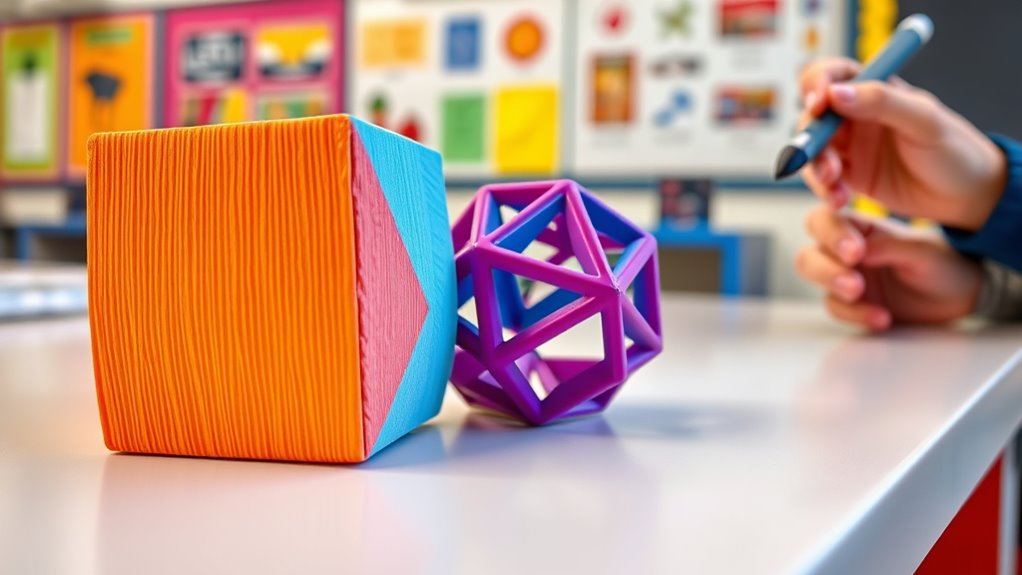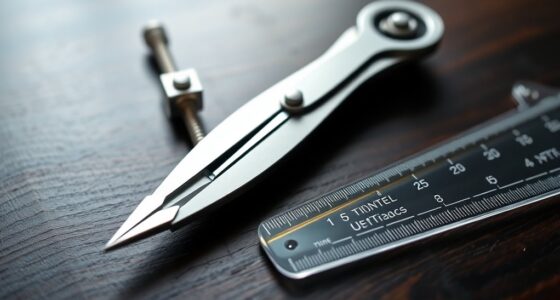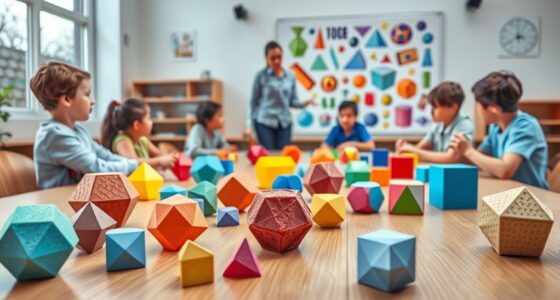Using 3D-printed models in geometry lessons allows you to offer students tangible, accurate shapes that make abstract concepts easier to grasp. These models boost visualization, enabling exploration from multiple angles and helping students recognize properties like symmetry and surface area. Combining physical models with virtual reality creates an engaging, immersive experience that caters to different learning styles. If you keep exploring, you’ll discover how this approach transforms your geometry teaching and student understanding.
Key Takeaways
- Utilize 3D-printed models to provide tangible, accurate representations of complex geometric shapes for enhanced understanding.
- Integrate virtual reality with physical models to create immersive, interactive learning experiences that deepen spatial comprehension.
- Tailor teaching strategies by combining hands-on handling with virtual exploration to accommodate diverse learning styles.
- Use models to illustrate properties like symmetry, angles, and surface area, making abstract concepts more accessible.
- Incorporate 3D-printed and virtual tools to foster curiosity, active participation, and long-term interest in geometry.

3D-printed models are transforming how you teach and learn geometry by providing tangible, accurate representations of complex shapes. These models make abstract concepts more concrete, helping students visualize and understand geometric structures that are often difficult to grasp through textbooks alone. When you incorporate 3D printing into your lessons, you create opportunities for students to explore shapes from multiple angles, gaining a deeper spatial awareness. This approach enhances their ability to recognize properties such as symmetry, angles, and surface area—fundamental skills in geometry. Furthermore, integrating virtual reality alongside 3D-printed models takes tactile learning to the next level. Virtual reality allows students to immerse themselves in a three-dimensional environment where they can manipulate shapes digitally, fostering an interactive experience that complements physical models. By combining these tools, you cater to different learning styles, especially for tactile and kinesthetic learners who benefit from hands-on experiences. Tactile learning, in particular, becomes more engaging when students physically handle 3D-printed objects, feeling the contours and edges that define a shape. This sensory interaction helps solidify understanding far better than passive observation. Virtual reality can simulate environments where students virtually “touch” and explore geometric forms, providing a safe and limitless space for experimentation. You can also use VR to demonstrate concepts that are challenging to produce physically, such as non-Euclidean geometries or multi-dimensional objects. The synergy between physical models and virtual reality creates an all-encompassing learning experience, enabling students to visualize the relationships between different shapes and understand their properties intuitively. As the teacher, you can guide students through a sequence where they first examine a physical 3D-printed model, then shift to a virtual environment to manipulate the same shape digitally. This layered approach reinforces understanding, allowing students to connect the tactile experience with virtual exploration. Additionally, you can utilize virtual reality to introduce complex or large-scale geometric concepts that are impractical to produce physically. The combination of 3D printing and VR not only makes lessons more interactive but also encourages curiosity and active participation. As students engage with these tools, they develop critical thinking skills, spatial reasoning, and a stronger grasp of geometric principles. Incorporating educational technology into your teaching strategies enhances engagement and learning outcomes in geometry lessons. Overall, integrating 3D-printed models and virtual reality into your teaching strategies transforms the way students perceive and comprehend geometry, making learning more dynamic, accessible, and impactful. This innovative approach prepares students for advanced mathematical concepts and real-world applications, fostering a love for geometry that lasts well beyond the classroom.
Frequently Asked Questions
How Cost-Effective Are 3d-Printed Models for Classroom Use?
You might wonder about the cost-effectiveness of 3D-printed models in your classroom. Compared to traditional materials, they often have a favorable cost comparison, especially for complex shapes that are costly to create otherwise. They also help with budget planning, as you can print multiple models for a fraction of the cost of buying ready-made ones. Overall, they offer a practical, reusable, and affordable way to enhance geometry lessons.
What Materials Are Best for Durable, Educational 3d-Printed Geometry Models?
When it comes to durability, you want materials that stand the test of time. ABS plastic is your best bet, offering high material durability and impact resistance. For finer details, printing resolution matters; SLA resin provides exceptional detail and smooth finishes. While PLA is easy to work with, it’s less durable. Choose your materials based on the model’s purpose—sturdiness or detail—and you’ll have reliable, educational tools that last.
How Can 3D Printing Be Integrated Into Existing Curriculum Standards?
You can integrate 3D printing into your curriculum by ensuring curriculum alignment and standard integration. Start by mapping 3D models to specific learning standards, demonstrating how they enhance understanding of concepts like shapes and spatial reasoning. Incorporate hands-on activities that complement lessons, and collaborate with colleagues to adapt existing units. This approach makes the technology a seamless part of your teaching, enriching student engagement and comprehension.
Are There Safety Concerns With 3D Printing in Classroom Environments?
Safety concerns with 3D printing in classrooms are serious but manageable. You might face hazards like burns or inhaling fumes, which could rival a volcano’s fury if ignored. You should follow strict safety protocols, including proper ventilation and protective gear. Additionally, careful material handling is essential to prevent accidents or exposure. Staying vigilant and educated guarantees a safe environment where you can enjoy the innovative benefits of 3D printing.
What Skills Do Teachers Need to Effectively Use 3d-Printed Models?
You need strong pedagogical strategies and technical proficiency to effectively use 3D-printed models. Focus on understanding how to integrate these models into lessons to enhance student engagement and comprehension. Develop skills in operating 3D printers, troubleshooting common issues, and maintaining safety protocols. By combining instructional techniques with technical know-how, you can maximize the educational benefits of 3D-printed models and create more interactive, hands-on learning experiences for your students.
Conclusion
Just like a sculptor shapes clay into stunning forms, you can turn 3D-printed models into powerful teaching tools. They make abstract concepts concrete, helping students see and touch geometry’s beauty. By incorporating these models into your lessons, you create an engaging learning experience that sparks curiosity and understanding. So, embrace 3D printing — it’s like giving your students a key to open the world of geometry right before their eyes.









